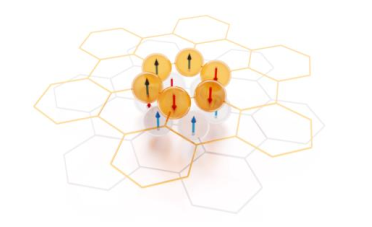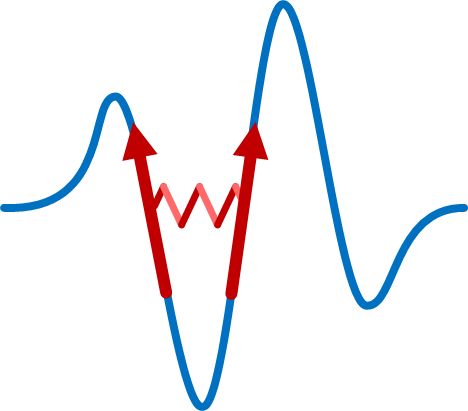Maria Chatzieleftheriou (CPHT, Ecole Polytechnique, Palaiseau)
Abstract : voir affiche jointe
Maria Chatzieleftheriou (CPHT, Ecole Polytechnique, Palaiseau)
Abstract : voir affiche jointe
Sophie WEBER (ETH-Zurich, Department of Materials, Zurich, Switzerland)
Theoretical arguments [1,2] and experimental measurements [3-6] have definitively shown that antiferromagnets (AFMs) with particular bulk symmetries can possess a nonzero magnetic dipole moment per unit area or “surface magnetization” on certain surface facets. Such surface magnetization underlies intriguing physical phenomena like interfacial magnetic coupling, and can be used as a readout method of antiferromagnetic domains. However, a universal description and understanding of antiferromagnetic surface magnetization is lacking. I first introduce a classification system based on whether the surface magnetization is sensitive or robust to roughness, and on whether the magnetic dipoles at the surface of interest are compensated or uncompensated. I then show that every type of surface magnetization can be identified and understood in terms of bulk magnetic multipoles, which are already established as symmetry indicators for bulk magnetoelectric responses [7]. This intimate correspondence between antiferromagnetic surface magnetization and magnetoelectric responses at both linear and higher orders reveals that selection and control of the antiferromagnetic order parameter via magnetoelectric annealing may be possible in many more materials and surfaces than previously believed. I use density functional calculations to illustrate that nominally compensated (10-10) and (-12-10) surfaces in magnetoelectric Cr2O3 develop a finite magnetization density at the surface, in agreement with our predictions based on both group theory and the ordering of the bulk multipoles. Finally, I present magnetotransport results by collaborators confirming our ab-initio and theoretical predictions of finite magnetization on these surfaces. Our analysis [8,9] provides a comprehensive basis for understanding the surface magnetic properties and their intimate correspondence to bulk magnetoelectric effects in antiferromagnets, and may have important implications for technologically relevant phenomena such as exchange bias coupling.
[1] A. F. Andreev, JETP Lett. 63, 756 (1996)
[2] K. D. Belashchenko, Phys. Rev. Lett. 105, 147204 (2010)
[3] X. H et al, Nature Mat. 9, 579 (2010)
[4] N. Wu et al., Phys. Rev. Lett. 106, 087202 (2011)
[5] P. Appel et al., Nano Lett. 19, 1682 (2019)
[6] M. S. Wörnle et al., Phys. Rev. B 103, 094426 (2021)
[7] N. A. Spaldin et al., Phys. Rev. B 88, 094429 (2013)
[8] S. F. Weber et al., arXiv:2306.06631 (2023)
[9] O. V. Pylypovskyi, S. F. Weber et al., arXiv 2310.13438 (2023)
Contact : Mébarek ALOUANI : mebarek.alouani@ipcms.unistra.fr
Dr. Svetlana Korneychuk (Karlsruhe Institute of Technology, Institute of Nanotechnology, Germany)
Abstract :
Hydrogen is one of the new energy sources which can take up a leading role in the transfer to the green economy. In this seminar I will demonstrate the application of in-situ TEM to the two major topics in the field of hydrogen technology.
In the first part, I will speak about solid oxide cells which play a key role in the energy transition. They use the chemical energy of the fuel, for instance, hydrogen to produce electricity in a clean way generating only heat and water in the process. Increasing the durability of solid oxide fuel cells is one of the main goals for achieving wider industrial application. The quality of the electrode plays a major role in the performance and durability of a fuel cell. Upon exposure to hydrogen and heat inside in-situ TEM, the reduction mechanism of NiO, a part of NiO/YSZ template for a fuel electrode, can be studied. Using in situ TEM atmosphere system from Protochips the electrode reduction at the H2 pressures up to 1 atmosphere and temperatures up to 850 °C are analyzed. In-situ results go in a good agreement with ex situ results obtained from a bulk cell reduced in a test bench.
Secondly, I am going to address the mechanism of the hydrogen absorption in the nanoscale systems on the example of Pd nanoparticles. Compared to bulk, nanoscale systems interact with hydrogen faster making them more attractive for hydrogen storage, hydrogen detection and catalysis. However, they reveal significant thermodynamic deviations from the bulk due to higher surface to volume ratio, absence of grain boundaries and mechanical stress. Pd is ideal model system to study hydrogen delivery in metals due to its high affinity to hydrogen. In this part I will show the behavior of Pd nanoparticles, in real time with in-situ H2-gas loading in TEM. Initial stages of hydrogen absorption in Pd nanoparticles, local formation of PdHx at different temperatures and pressures can be analyzed by measuring the shift of Pd bulk plasmon with STEM-EELS during in-situ hydrogen loading and unloading in TEM.
Contact : Florian Banhart (florian.banhart@ipcms.unistra.fr)
Anna GALLER / Institute of Theoretical and Computational Physics, Graz University of Technology, Austria
Abstract : Optical phenomena in solids are fascinating and of great importance for technological applications. In this talk, I will first present a novel approach to compute the optical response and color of new inorganic pigment materials from first principles. I will show that the brilliant colors of my target materials, certain transition-metal oxides and rare-earth semiconductors, are strongly influenced by the presence of transition-metal and rare-earth electronic states, whose theoretical treatment requires elaborate many-body techniques.
The second part of the seminar will be focused on nonlinear optical phenomena. I will investigate the response of monolayer hexagonal boron nitride, a prototypical 2D semiconductor, to intense ultrafast laser pulses. I will show that the conduction band charge occupation induced by an elliptically polarized laser can be understood in a multi-photon resonant picture, but remarkably, only if using the Floquet light-dressed states instead of the undressed matter states.
[1] Ransmayr, Tomczak and Galler, PRM 6, 105003 (2022)
[2] Galler, Rubio and Neufeld, J. Phys. Chem. Lett. 14, 50, 11298–11304 (2023)
Pour tout contact : Mébarek ALOUANI : mebarek.alouani@ipcms.unistra.fr
Maxime Durelle (University of Leeds, UK)
Crystallisation in solution is a very common natural and industrial process, but is still poorly understood. Many different processes such as biomineralisation or industrial precipitation imply a nucleation step, but recent literature has shown that non-crystalline transient states often form prior to crystallization., These transient states are, by construction, overlooked by classical nucleation theory, but their direct influence on the nucleation mechanism is still highly debated.5
In this work we propose to investigate how the transient state, which is often small both in size and lifetime, can have a control on the nucleation mechanism. In this regard, we will study two systems, namely the cerium oxalate and the calcium carbonate, which are known to be formed by transient species. This work will aim to confirm or refute three hypotheses: (i) the chemical conditions in the precursor solution do not only affect the composition of the transient state, but also it’s local and long-range structure, (ii) crystallisation kinetics, and even the mechanism, are determined by the structure of the transient state and (iii) the structure of the transient species will alter the nucleation mechanism.
Here we show that (i) concentration and additives change not only the composition but also the structure of the transient species formed prior to the nucleation step, (ii) that the nucleation rate and the dependence of the nucleation rate on supersaturation change drastically with the structure of the transient state, and (iii) that a liquid-like or a solid-like structure of the transient species seems to induce two different nucleation mechanisms.
The defense will take place on Friday, December 8th, 2023, at 1:30 PM in the auditorium of IPCMS.
This PhD was carried out under the supervision of Pr. Ovidiu ERSEN (IPCMS, Strasbourg) and Pr. Clément SANCHEZ (LCMCP, Collège de France, Paris, USIAS).
The defense will take place on Monday December 4, 2023 at 2pm in the IPCMS auditorium. This thesis work was carried out under the supervision of Prof. Ovidiu ERSEN (IPCMS, Strasbourg) and Dr Virgile ROUCHON (IFPEN, Lyon).
This work was carried out under the co-direction of Dr. Christine Boegli (DSI) and Dr. Matthieu Bailleul (DMONS).
The defense will take place on Friday, September 22th at 2:00 p.m. in the IPCMS’ Auditorium
These works were carried out under the supervision of Dietmar Weinmann at IPCMS in the DMONS department.
The defense will take place on Friday, September 29th, 2023 at 10:00 a.m: in the IPCMS auditorium.


Abdelghani Laraoui (Department of Mechanical & Materials Engineering, University of Nebraska-Lincoln)
Abstract :
Magnetic microscopy based on nitrogen vacancy (NV) centers in diamond has become a versatile tool to detect magnetic fields with an unprecedented combination of spatial resolution and magnetic sensitivity, opening up new frontiers in biological [1] and condensed physics matter research [2]. In this seminar, I will present two examples of using NV magnetic microscopy in both scanning probe microscopy (SPM) and wide-field microscopy (WFM) geometries to study nanoscale magnetic phenomena in different materials. First, I will discuss NV-SPM measurements of antiferromagnetic (AFM) domains switching in Cr2O3 and B-Cr2O3 thin films and device structures [3, 4]. Cr2O3 is an archetypical AFM oxide that permits voltage-control of the Néel vector. In addition, boron doping increases Néel temperature from 307 K to 400 K and allows realizing voltage controlled Néel vector at zero applied magnetic field, a promising finding to AFM spintronics. Then, I will discuss NV-WFM measurements on individual Fe(Htrz)2(trz)](BF4)] (Fe triazole) spin-crossover (SCO) nano-rods of size varying from 20 to 1000 nm [5]. Fe triazole SCO complexes exhibit thermal switching between low spin (LS) and high spin (HS) states which are applicable in thermal sensors and molecular switches. While the bulk magnetic properties of these molecules are widely studied by bulk magnetometry techniques their properties at the individual level are missing. The stray magnetic fields produced by individual Fe-triazole nano-rods are imaged by NV magnetic microscopy as a function of temperature (up to 150 0C) and applied magnetic field (up to 3500 G). We found that in most of the nanorods the LS state is slightly paramagnetic, possibly originating from the surface oxidation and/or the greater Fe(III) presence along the nanorods’ edges [5].
References: [1] I. Fescenko, A. Laraoui, et al., Phys. Rev. App. 11, 034029 (2019). [2] A. Laraoui and K.
Ambal, Appl. Phys. Lett. 121, 060502 (2022). [3] A. Erickson, A. Laraoui, et al., RSC Adv. 13, 178-185 (2023).
[4] A. Erickson, A. Laraoui, et al., to be submitted to Nat. Mat. (2023). [5] S. Lamichhane, A. Laraoui, et al.,
ACS Nano 17, 9, 8694–8704 (2023).
Contact : Valérie Halté (valerie.halte@ipcms.unistra.fr)